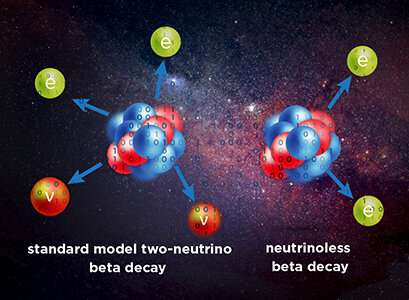Researchers develop novel approach to modeling yet-unconfirmed rare nuclear process

Researchers from the Facility for Rare Isotope Beams (FRIB) Laboratory at Michigan State University (MSU) have taken a major step toward a theoretical first-principles description of neutrinoless double-beta decay. Observing this yet-unconfirmed rare nuclear process would have important implications for particle physics and cosmology. Theoretical simulations are essential to planning and evaluating proposed experiments. The research team presented their results in an article recently published in Physical Review Letters.
FRIB theorists Jiangming Yao, research associate and the lead author of the study, Roland Wirth, research associate, and Heiko Hergert, assistant professor, are members of a topical collaboration on fundamental symmetries and neutrinoless double-beta decay. The U.S. Department of Energy Office of Science Office of Nuclear Physics is funding the topical collaboration. The theorists joined forces with fellow topical collaboration members from the University of North Carolina-Chapel Hill and external collaborators from the Universidad Autonoma de Madrid, Spain. Their work marks an important milestone toward a theoretical calculation of neutrinoless double-beta decay rates with fully controlled and quantified uncertainties.
The authors developed the In-Medium Generator-Coordinate Method (IM-GCM). It is a novel approach for modeling the interactions between nucleons that is capable of describing the complex structure of the candidate nuclei for this decay. The first application of IM-GCM to the computation of the neutrinoless double beta decay rate for the nucleus of calcium-48 sets the stage for explorations of the other candidates with controllable theoretical uncertainty.
In neutrinoless double-beta decay, two protons simultaneously transform into neutrons without emitting the two neutrinos that appear in more typical weak-interaction processes. If it exists, this is an extremely rare decay that is expected to have a half-life greater than 10 septillion years (a 1 with 25 zeroes), which means that half of a sample of nuclei would have undergone neutrinoless double beta-decay in this extremely long period.
Its observation would demonstrate that neutrinos are their own antiparticles. Every subatomic particle has a corresponding antiparticle, which has the same mass but an equal and opposite charge. Particles and antiparticles can annihilate each other, leaving only energy. Hence, no neutrinos would be observed in neutrinoless double-beta decay. A neutrinoless double-beta decay observation would show that a fundamental law—the conservation of lepton number—is violated in nature. This could help explain why the universe contains more matter than antimatter, which consists of the aforementioned antiparticles. The observation would also direct efforts to complete the Standard Model of particle physics.
"The absence of neutrinos in this yet-unconfirmed decay makes it possible to determine the neutrino masses," said Hergert. "These masses are an important parameter in models of the evolution of the universe. The theoretical decay rate is a key ingredient in the extraction of the neutrino masses from the measured lifetime, or at least provides new upper limits on these quantities."
Theoretical calculations like those presented by the authors will also help determine the size of the detectors needed for large-scale neutrinoless double-beta decay experiments.
Developing and implementing tests of fundamental symmetries is an important element of FRIB's mission. FRIB experiments explore the structure of neutrinoless double beta decay candidates and their neighboring isotopes, which affects the rate at which the decay might occur. The theoretical methods developed for this study can now be applied to other nuclei with complex structures that are studied at FRIB.
More information: J. M. Yao et al, Ab Initio Treatment of Collective Correlations and the Neutrinoless Double Beta Decay of Ca48, Physical Review Letters (2020). DOI: 10.1103/PhysRevLett.124.232501
Journal information: Physical Review Letters
Provided by Michigan State University




















